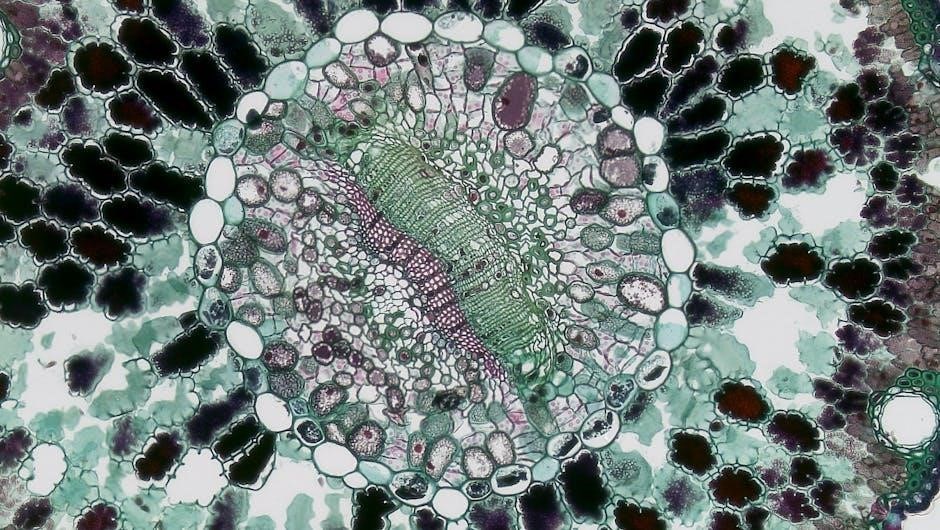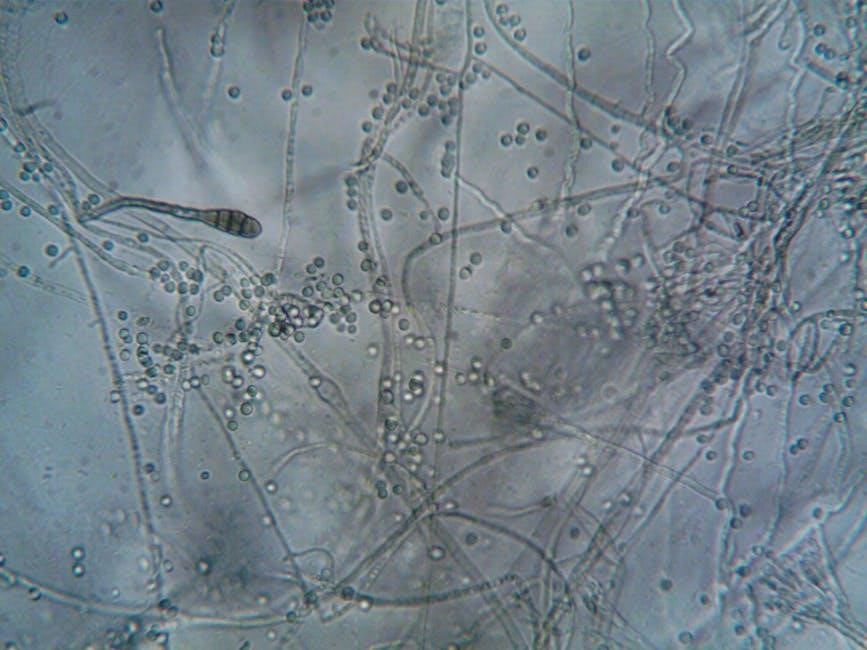Photosynthesis and cellular respiration are essential biological processes that sustain life on Earth. Photosynthesis converts light energy into chemical bonds, while cellular respiration releases energy from these bonds.
1.1 Importance of Photosynthesis and Cellular Respiration
Photosynthesis and cellular respiration are fundamental processes that sustain life on Earth. Photosynthesis provides oxygen and energy for organisms, while cellular respiration releases energy stored in glucose.
These processes are interconnected, forming a cycle that maintains ecological balance. Photosynthesis captures sunlight to produce glucose, which cellular respiration breaks down to release energy. This interdependence ensures the survival of nearly all living organisms, making these processes vital for life as we know it.
1.2 Overview of the Interconnectedness of Both Processes
Photosynthesis and cellular respiration form a cyclical relationship, exchanging oxygen and carbon dioxide. Photosynthesis produces oxygen and glucose, which are essential for cellular respiration. Conversely, cellular respiration generates carbon dioxide and water, which are vital for photosynthesis. This interconnectedness creates a balanced ecosystem, ensuring energy flow and sustaining life.
The processes are interdependent, with photosynthesis in plants supporting respiration in both plants and animals. This exchange maintains ecological harmony, allowing energy from sunlight to circulate through the biosphere and support all living organisms.

Photosynthesis: The Basics
Photosynthesis converts light energy into chemical energy, using chlorophyll, carbon dioxide, and water to produce oxygen and glucose. It occurs in chloroplasts and is vital for life.
2.1 Photosynthesis Equation and Its Components
The photosynthesis equation is 6CO₂ + 6H₂O + light energy → C₆H₁₂O₆ + 6O₂. This equation shows how carbon dioxide and water, using sunlight, produce glucose and oxygen. Carbon dioxide and water are the reactants, while glucose (energy-rich sugar) and oxygen are the products. The equation highlights the conversion of light energy into chemical energy, stored in glucose. Understanding this equation is fundamental for grasping the process of photosynthesis and its role in sustaining life on Earth.
2.2 Stages of Photosynthesis: Light-Dependent and Light-Independent Reactions
Photosynthesis occurs in two main stages: the light-dependent reactions and the light-independent reactions. The light-dependent reactions take place in the thylakoid membranes of chloroplasts, where light energy is absorbed and converted into ATP and NADPH. Water is split, releasing oxygen as a byproduct. The light-independent reactions, also known as the Calvin Cycle, occur in the stroma. Here, CO₂ is fixed into glucose using the ATP and NADPH produced earlier. These stages work together to convert light energy into chemical energy stored in glucose.
2.3 Structure and Function of Chloroplasts
Chloroplasts are organelles found in plant cells, responsible for photosynthesis. They have a double membrane structure with thylakoids stacked into grana. The thylakoid membranes contain pigments like chlorophyll, which absorb light energy, while the stroma houses enzymes for carbon fixation. Chloroplasts are essential for converting light energy into chemical energy through photosynthesis, producing ATP and NADPH. These organelles are crucial for energy storage and oxygen release, sustaining life on Earth.
2.4 Factors Affecting Photosynthesis
Photosynthesis is influenced by several factors, including light intensity, carbon dioxide concentration, temperature, and chlorophyll availability. Increased light intensity enhances photosynthesis up to a point, beyond which it may cause photoinhibition. Higher CO2 levels also boost the process, while low temperatures slow it down; Optimal conditions vary among plant species, and factors like water availability and nutrient supply further modulate efficiency. Understanding these factors is crucial for maximizing plant growth and energy production in various environments.

Cellular Respiration: The Basics
Cellular respiration is a process where cells break down glucose to produce ATP, releasing energy for cellular functions. It occurs in all living organisms, converting biochemical energy into usable forms, essential for sustaining life and supporting metabolic activities.
3.1 Cellular Respiration Equation and Its Components

The cellular respiration equation is: C₆H₁₂O₆ + 6O₂ → 6CO₂ + 6H₂O + ATP (energy). This process involves breaking down glucose (C₆H₁₂O₆) using oxygen (O₂), producing carbon dioxide (CO₂), water (H₂O), and energy in the form of ATP. Glucose is the primary energy source, while oxygen acts as the final electron acceptor. The products, CO₂ and H₂O, are byproducts of glucose oxidation. This equation highlights the conversion of chemical energy stored in glucose into usable energy (ATP), essential for cellular functions.
3.2 Stages of Cellular Respiration: Glycolysis, Krebs Cycle, and Electron Transport Chain
Cellular respiration occurs in three stages: glycolysis, the Krebs cycle, and the electron transport chain. Glycolysis breaks glucose into pyruvate, generating small amounts of ATP and NADH. The Krebs cycle converts pyruvate into acetyl-CoA, producing more ATP, NADH, and FADH2 while releasing CO₂. The electron transport chain uses these molecules to create a proton gradient, driving ATP synthase to produce large amounts of ATP. Oxygen acts as the final electron acceptor, forming water. Together, these stages efficiently extract energy from glucose for cellular use.
3.3 Structure and Function of Mitochondria
Mitochondria are often called the “powerhouses” of eukaryotic cells due to their role in energy production. Their double-membrane structure includes a folded inner membrane that forms cristae, increasing surface area for ATP production. The matrix contains enzymes for the Krebs cycle, converting pyruvate into ATP, NADH, and FADH2. The electron transport chain, located in the inner membrane, uses these molecules to generate a proton gradient, driving ATP synthase to produce ATP. This process is essential for cellular respiration, enabling cells to efficiently harness energy from glucose.
3.4 Factors Affecting Cellular Respiration
Several factors influence the rate of cellular respiration, including glucose availability, oxygen levels, temperature, and enzyme activity. Increased glucose concentration enhances glycolysis, while limited oxygen slows the electron transport chain. Temperature affects enzyme efficiency, with optimal ranges varying by organism. Enzyme availability and co-factors like NAD+ and FAD also play critical roles. These factors interact to regulate energy production, ensuring cells adapt to changing conditions and maintain metabolic balance. Understanding these elements is crucial for grasping how cells optimize energy production.

Relationship Between Photosynthesis and Cellular Respiration
Photosynthesis and cellular respiration are interconnected processes. Photosynthesis produces oxygen and glucose, while cellular respiration uses them, releasing carbon dioxide. This energy exchange sustains life.
4.1 Exchange of Oxygen and Carbon Dioxide
The exchange of oxygen and carbon dioxide is a cornerstone of the relationship between photosynthesis and cellular respiration. During photosynthesis, plants release oxygen into the atmosphere as a byproduct, while cellular respiration uses this oxygen to produce energy. Conversely, cellular respiration releases carbon dioxide, which plants absorb to fuel photosynthesis. This cyclical exchange sustains life, maintaining atmospheric balance and ensuring the survival of both plants and animals. It highlights the interdependence of these processes in ecosystems worldwide.
- Photosynthesis produces oxygen, essential for cellular respiration.
- Cellular respiration produces carbon dioxide, vital for photosynthesis.
4.2 Energy Conversion: ATP and Glucose
Photosynthesis and cellular respiration are linked through energy conversion, with ATP and glucose playing central roles. Photosynthesis captures sunlight to produce glucose, storing energy in chemical bonds. This glucose is then broken down during cellular respiration, releasing energy that is stored in ATP. ATP serves as the primary energy currency of cells, powering essential functions. This energy cycle ensures that sunlight is efficiently converted, stored, and utilized, maintaining life’s processes.
- Photosynthesis converts light energy into glucose and ATP;
- Cellular respiration breaks down glucose, generating ATP.
Study Tips and Resources

Master photosynthesis and cellular respiration with diagrams, flashcards, and practice quizzes. Use tools like the Search Strategy Builder for effective learning and concept retention.
- Utilize visual aids and summaries.
- Practice with past exam questions.
5.1 Key Terms and Concepts to Memorize
Mastering key terms is crucial for understanding photosynthesis and cellular respiration. Essential concepts include photosynthesis, cellular respiration, chloroplasts, mitochondria, ATP, glucose, oxygen, and carbon dioxide. Understand the roles of light-dependent and light-independent reactions, glycolysis, the Krebs cycle, and the electron transport chain. Memorize the chemical equations for both processes and their interconnection. Focus on how energy flows between these processes and their importance in sustaining life. Use flashcards and diagrams to reinforce these concepts for better retention and clarity.
5.2 Recommended Diagrams and Visual Aids
Visual aids are invaluable for mastering photosynthesis and cellular respiration. Start with diagrams of chloroplast and mitochondrion structures, highlighting where each process occurs. Use flowcharts to illustrate the Calvin cycle and Krebs cycle, showing how molecules transform. Energy flow diagrams between plants and animals clarify the interconnectedness of these processes. Interactive 3D models and videos can enhance understanding of light-dependent reactions and the electron transport chain. Include labeled infographics to summarize key terms and concepts, making study sessions more efficient and engaging.

5.3 Practice Questions and Quizzes
Practicing with targeted questions is crucial for mastering photosynthesis and cellular respiration. Begin with multiple-choice questions on the equations and stages of each process. Use true/false statements to clarify common misconceptions, such as the role of mitochondria and chloroplasts. Include fill-in-the-blank exercises to memorize key terms like “Calvin cycle” or “electron transport chain.” Matching exercises can link reactants to products or processes to their locations. Finally, essay questions can assess your ability to explain the interconnection between these processes. Utilize online quizzes and flashcards for self-assessment.

Common Misconceptions and Clarifications
A common misconception is confusing the roles of chloroplasts and mitochondria; Chloroplasts are for photosynthesis, while mitochondria handle cellular respiration, yet both are energy-focused.
6.1 Understanding the Role of Chloroplasts and Mitochondria
A common misconception is that chloroplasts and mitochondria are interchangeable. Chloroplasts, found in plants, are the site of photosynthesis, converting sunlight into glucose. Mitochondria, present in most cells, are the hub of cellular respiration, breaking down glucose to release energy. Both organelles are crucial for energy production but function in opposite processes. Chloroplasts capture energy, while mitochondria release it, highlighting their complementary roles in sustaining life.
6.2 Clarifying the Direction of Energy Flow
A common misunderstanding is the direction of energy flow between photosynthesis and cellular respiration. Energy flows unidirectionally, from sunlight captured during photosynthesis to the chemical bonds in glucose. Cellular respiration then releases this stored energy, breaking down glucose into carbon dioxide and water. While the processes are interconnected, energy does not flow backward from respiration to photosynthesis. This clarifies that energy is not recycled but flows linearly, supporting life by powering biological functions and ecosystems.
Understanding photosynthesis and cellular respiration is crucial for grasping life’s energy flow. These processes sustain ecosystems and highlight nature’s efficient energy cycles. Mastering these concepts is key.
7.1 Summary of Key Points

Photosynthesis and cellular respiration are vital processes that sustain life by converting energy and exchanging gases. Photosynthesis uses sunlight to produce glucose and oxygen, while cellular respiration breaks down glucose to release energy. Both processes rely on chloroplasts and mitochondria, respectively. Key stages include light-dependent reactions, Calvin cycle, glycolysis, Krebs cycle, and electron transport chains. Understanding these processes highlights their interdependence and essential role in maintaining Earth’s ecosystems. Mastering these concepts provides a foundation for advanced biology studies.
7.2 Final Tips for Mastering the Topic
To excel in understanding photosynthesis and cellular respiration, focus on their interconnection and energy flow. Use diagrams to visualize processes like the Calvin cycle and Krebs cycle. Memorize key equations and the roles of chloroplasts and mitochondria. Practice with flashcards for terms like ATP, NADH, and glucose. Engage in active learning by teaching concepts to others or discussing with peers. Regularly review and apply concepts through practice questions. Emphasize the exchange of oxygen and carbon dioxide, as well as energy conversion, to grasp their significance in sustaining life.



0 Comments